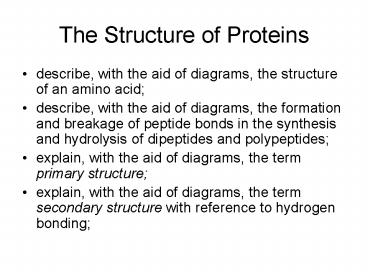The Structure of Proteins - PowerPoint PPT Presentation
Title:
The Structure of Proteins
Description:
The Structure of Proteins describe, with the aid of diagrams, the structure of an amino acid; describe, with the aid of diagrams, the formation and breakage of ... – PowerPoint PPT presentation
Number of Views:104
Avg rating:3.0/5.0
Title: The Structure of Proteins
1
The Structure of Proteins
- describe, with the aid of diagrams, the structure
of an amino acid - describe, with the aid of diagrams, the formation
and breakage of peptide bonds in the synthesis
and hydrolysis of dipeptides and polypeptides - explain, with the aid of diagrams, the term
primary structure - explain, with the aid of diagrams, the term
secondary structure with reference to hydrogen
bonding
2
Protein Uses
- Proteins are large molecules made up of the
elements carbon, hydrogen, oxygen and nitrogen.
Some proteins also contain sulphur. - Try to write down 5 uses for proteins
- Structural components e.g. muscle or bone
- Membrane carriers and pores for active transport
and facilitated diffusion - Enzymes
- Hormones
- antibodies
3
- All proteins are made of repeating units called
amino acids - We call a large molecule made of repeating units
a polymer - The individual sub-units (like amino acids) are
called monomers - Many monomers join together to make a polymer
- All amino acids have the same basic structure,
an amino group at one end, a carboxyl (or acid)
group at the other, and a carbon atom in between - The R group at the top stands for one of 20 sets
of atoms that make all 20 amino acids different - In glycine (the simplest amino acid), the R
group is just a Hydrogen atom (H)
4
(No Transcript)
5
Task
- Using Cambridge Biology p108-109, write about how
amino acids are linked together to form a
polypeptide - You must include a diagram, and must also use the
key terms that follow - Peptide bond, covalent bond, condensation
reaction, polypeptide, - When finished, complete SAQ 2 a and b
6
(No Transcript)
7
This is now called a dipeptide. Joining more will
create a polypeptide
Now explain how amino acids split apart, using a
diagram and a description including the key word
hydrolysis
8
Questions
- What are essential amino acids?
- The backbone for a molecule with 4 amino acids
is
N-C-C-N-C-C-N-C-C-N-C-C, draw this
out in full, showing the amino acids joined and
the peptide bonds formed - How many molecules of water would be produced in
forming this amino acid chain? - Why do we call this a polypeptide?
9
Questions
- What are essential amino acids? amino acids found
in meat mostly- animals cannot make them in the
liver - The backbone for a molecule with 4 amino acids
is
N-C-C-N-C-C-N-C-C-N-C-C, draw this
out in full, showing the amino acids joined and
the peptide bonds formed - How many molecules of water would be produced in
forming this amino acid chain? 3 molecules of
water will be formed - Why do we call this a polypeptide? A molecule
containing many peptide bonds
10
(No Transcript)































